How to Choose and Test SEM Bidding Strategies to Improve Your Bid Management
While running a PPC campaign, if bidding strategies is the term that you fear the most, we’re here to help.
Let’s be honest. Though PPC is known for generating quick and impressive results, it comes with a cost. You pay for each click. So, it’s only normal to be more than a little cautious while choosing the right bidding strategy for your campaign.
Wondering what bidding strategies are there and how to decide the right one for you?
Leave your worries aside cause whether you’re aiming to boost conversions, maximize ROI, or optimize campaigns, we’ve got you covered.
So, join us as we simplify it for you (in a way you understand) and equip you with the knowledge to elevate your bid management skills.
What Are Bidding Strategies?
Bidding strategies play a pivotal role in determining the success of SEM campaigns, dictating how advertisers allocate their budgets and compete for ad placements.
Essentially, bidding strategies determine the amount an advertiser is willing to pay for a click or conversion on their ads.
These strategies encompass a range of techniques, from manual bidding, where advertisers set bids themselves, to automated bidding, where algorithms adjust bids based on predefined goals.
The choice of bidding strategy depends on factors such as campaign objectives, budget constraints, and the level of control desired.
By understanding the intricacies of bidding strategies and strategically adjusting bids for keywords and ad placements, advertisers can optimize their PPC campaigns‘ ad spend for maximum performance and return on investment.
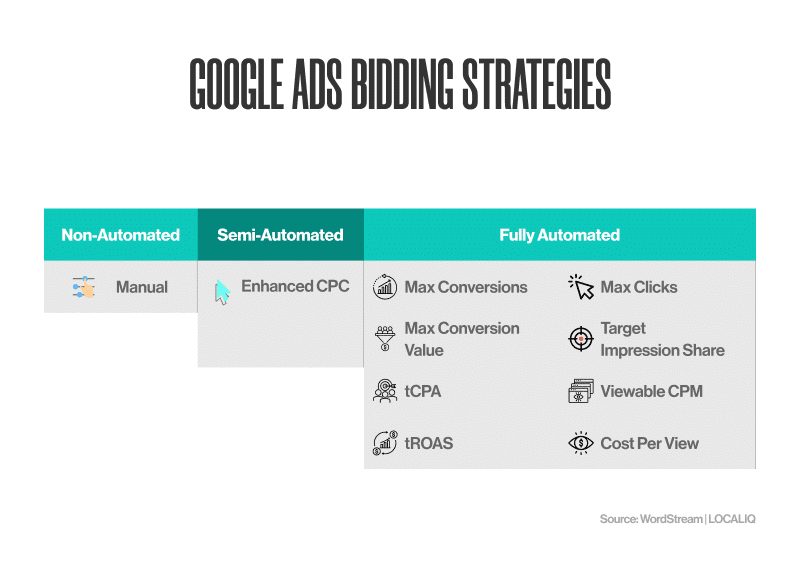
SEM Bidding Strategies
In this blog, we’ll explore seven essential bidding strategies that advertisers can employ to improve bid management and enhance the performance of their SEM campaigns.
1. Manual Bidding
Manual bidding is a bidding strategy in which advertisers manually set bids for their keywords or ad placements. Unlike automated bidding strategies, which rely on algorithms to adjust bids, manual bidding gives advertisers full control over their bidding decisions.
Advertisers can set bids at the keyword or ad group level, allowing for granular control over budget allocation and bid adjustments.
When to Use It:
- Complex Campaigns: Manual bidding is suitable for campaigns with complex goals or target audiences that may require personalized bidding strategies.
- Testing Phase: It’s beneficial during the initial testing phase of a campaign when advertisers want to closely monitor performance and make strategic bid adjustments.
- Limited Budget: For advertisers with a limited budget, manual bidding allows for precise control over spending and ensures bids are allocated efficiently.

Pros:
- Full Control: Advertisers have complete control over bid amounts, allowing for strategic adjustments based on performance metrics and campaign objectives.
- Flexibility: Manual bidding offers flexibility to adjust bids at the keyword or ad group level, enabling advertisers to tailor bidding strategies to specific segments of their audience.
- Budget Management: With manual bidding, advertisers can allocate budgets more effectively and prioritize spending on high-value keywords or placements.
Cons:
- Time-Consuming: Manual bidding requires ongoing monitoring and adjustments, which can be time-consuming, especially for large campaigns with numerous keywords.
- Limited Scalability: For advertisers managing large-scale campaigns, manual bidding may not be scalable, as it requires individual bid management for each keyword or ad group.
- Risk of Inefficiency: Without automated optimization, there is a risk of inefficiency or missed opportunities to capture valuable traffic or conversions, especially in dynamic auction environments.
Automated Bidding
Automated bidding strategies take the guesswork out of setting PPC ad bids. Instead of manually adjusting bids for each keyword, you let an algorithm do the heavy lifting.
It analyzes factors like user search intent, device, and past performance to automatically set bids that maximize your clicks, conversions, or return on ad spend, all within your set budget.
There are a total of five automated bidding strategies that advertisers can choose from according to the nature of their campaign.
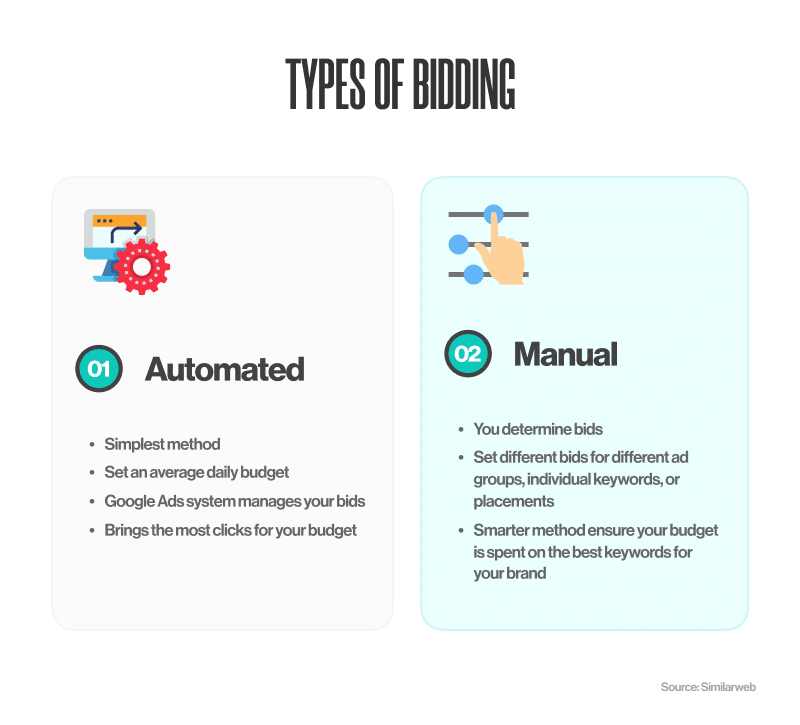
2. Target CPA (Cost-Per-Acquisition)
The first on our list of automated bidding strategies is Target CPA (Cost-Per-Acquisition) bidding which allows advertisers to set a target cost-per-acquisition for their campaigns.
CPA refers to the cost incurred by the advertiser for each acquisition, such as a sale or lead.
With Target CPA bidding, advertisers specify the amount they are willing to pay for each acquisition, and the bidding algorithm adjusts bids in real time to meet that target while maximizing conversions.
This strategy leverages machine learning to optimize bids based on historical data and conversion likelihood, ultimately aiming to achieve the desired CPA efficiently.
When to Use It:
- Lead Generation Campaigns: Target CPA bidding is ideal for lead generation campaigns where advertisers aim to acquire leads at a specific cost.
- Fixed Acquisition Costs: When advertisers have a predetermined target CPA or maximum allowable acquisition cost, Target CPA bidding ensures bids are optimized to meet those targets.
- Stable Conversion Rates: This strategy works best when conversion rates are relatively stable, allowing the bidding algorithm to accurately predict and optimize for future conversions.
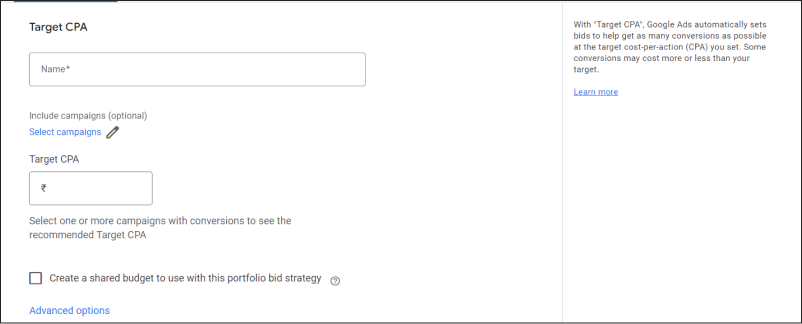
Pros:
- Efficient Acquisition: Target CPA bidding optimizes bids to achieve the desired cost-per-acquisition efficiently, helping advertisers acquire customers or leads at a predetermined cost.
- Automated Optimization: The bidding algorithm automatically adjusts bids based on conversion data and historical performance, saving advertisers time and effort in bid management.
- Performance Insights: Advertisers gain valuable insights into campaign performance and conversion metrics. This allows for data-driven decision-making and optimization.
Cons:
- Learning Period: Target CPA bidding may require a learning period for the algorithm to adjust bids effectively and stabilize performance. This potentially results in fluctuations in conversion volume or cost initially.
- Limited Control: Advertisers have limited control over individual bid adjustments with Target CPA bidding. As bids are optimized automatically based on the target CPA.
- Campaign Complexity: For campaigns with diverse conversion actions or variable conversion values. Target CPA bidding may not be suitable, as it optimizes bids solely based on the target CPA without considering other factors.
3. Target ROAS (Return On Ad Spend)
The second on our list of automated bidding strategies is Target ROAS (Return On Ad Spend) bidding which allows advertisers to set a target return on ad spend for their campaigns.
ROAS indicates how much revenue is earned from each advertising dollar. With Target ROAS bidding, advertisers specify the desired ROAS value. The bidding algorithm adjusts bids in real time to maximize revenue while maintaining or exceeding the target ROAS.
This strategy leverages machine learning to optimize bids based on the expected value of clicks and the likelihood of conversion. This ultimately aims to achieve the desired return on ad spend efficiently.
When to Use It:
- E-commerce Campaigns: Target ROAS bidding is particularly effective for e-commerce campaigns where advertisers aim to maximize revenue while maintaining a profitable return on ad spend.
- Variable Conversion Values: When advertisers have different products or services with varying profit margins or conversion values. Target ROAS bidding can optimize bids accordingly to maximize overall revenue.
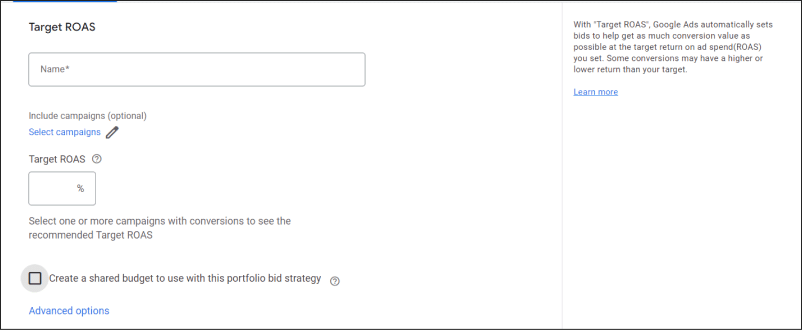
Pros:
- Maximized Revenue: Target ROAS bidding optimizes bids to maximize revenue while maintaining or exceeding the desired return on ad spend. This helps advertisers achieve their revenue goals more efficiently.
- Automated Optimization: The bidding algorithm automatically adjusts bids based on conversion data and revenue metrics. This helps advertisers save their time and effort in bid management.
- Flexible Targeting: Advertisers can set different target ROAS values for different campaigns or ad groups. This allows for flexible targeting and optimization based on campaign objectives and performance goals.
Cons:
- The cons of the learning period and limited control are the same as mentioned above.
- Complex Conversion Paths: For campaigns with complex conversion paths or long sales cycles, Target ROAS bidding may not capture the full value of conversions. As it optimizes bids based on immediate revenue rather than lifetime customer value.
4. Maximize Conversions
The third on our list of automated bidding strategies is Maximize Conversions bidding which aims to drive the highest possible number of conversions within a specified budget.
With this strategy, advertisers set a daily budget, and the bidding algorithm automatically adjusts bids to maximize the number of conversions their ads generate.
Maximize Conversions bidding leverages machine learning to optimize bids based on historical data and conversion likelihood. This ultimately aims to achieve the highest possible conversion volume while staying within budget constraints.
When to Use It:
- Conversion-Oriented Campaigns: Maximize Conversions bidding is ideal for campaigns focused on driving specific conversion actions. Such as purchases, sign-ups, or downloads.
- Budget Optimization: When advertisers have a fixed budget and want to maximize the number of conversions they generate with that budget, Maximize Conversions bidding can help allocate bids efficiently.
- Variable Conversion Values: This strategy works well for campaigns with variable conversion values or multiple conversion actions. As bids are optimized based on the overall conversion volume rather than individual conversion values.

Pros:
- Maximized Conversions: Maximize Conversions bidding optimizes bids to drive the highest possible number of conversions within the specified budget. This helps advertisers achieve their conversion goals more efficiently.
- Automated Optimization: The bidding algorithm automatically adjusts bids based on conversion data and historical performance. This helps advertisers save their time and effort in bid management.
- Budget Control: Advertisers have control over their daily budget, allowing them to set limits on ad spend while still maximizing conversions.
Cons:
- The cons of the learning period and limited control are the same as mentioned above.
- Risk of Inefficiency: Without careful monitoring, there is a risk that automated bid adjustments may lead to inefficiencies or increased costs if not aligned with campaign goals or performance targets.
Suggested Read: 5 Effective Tips to Optimize Your Google Ads Campaign to Boost Conversions
5. Maximize Clicks
The fourth on our list of automated bidding strategies is Maximize Clicks bidding which aims to drive the highest possible number of clicks within a specified budget.
With this strategy, advertisers set a daily budget, and the bidding algorithm automatically adjusts bids to maximize the number of clicks their ads receive.
Maximize Clicks bidding is ideal for advertisers looking to increase website traffic and visibility, regardless of the conversion outcome.
When to Use It:
- Brand Awareness: Maximize Clicks bidding is effective for brand awareness campaigns where the primary goal is to drive traffic to the website and increase brand visibility.
- Limited Conversion Tracking: When advertisers have limited conversion tracking or are unable to measure specific conversion actions, Maximize Clicks bidding can help optimize for overall website traffic.
- Budget Flexibility: Advertisers with flexible budgets who prioritize maximizing clicks over other performance metrics can benefit from this strategy.

Pros:
- Increased Traffic: Maximize Clicks bidding helps advertisers maximize website traffic by automatically adjusting bids to drive the highest possible number of clicks within the specified budget.
- Budget Control: Advertisers have control over their daily budget, allowing them to set limits on ad spend while still maximizing clicks.
- Simplicity: This bidding strategy is easy to set up and manage, making it suitable for advertisers who prioritize simplicity and convenience.
Cons:
- Limited Conversion Focus: Maximize Clicks bidding prioritizes clicks over conversions, which may not be suitable for advertisers with specific conversion goals or performance targets.
- Potential for Irrelevant Traffic: Maximizing clicks may lead to increased traffic but not necessarily qualified leads or conversions. This results in potentially lower conversion rates or return on investment.
- Budget Exhaustion: Without careful monitoring, there is a risk of exhausting the daily budget quickly. Especially if clicks are expensive or competition is high in the auction.
6. Target Impression Share
The fifth on our list of automated bidding strategies is Target Impression Share bidding which allows advertisers to set a target impression share for their ads.
Impression share refers to the percentage of ad impressions that your ads receive compared to the total number of impressions your ads were eligible to receive.
With Target Impression Share bidding, advertisers specify their desired impression share. Such as absolute top impression share, top of page impression share, or any position impression share. The bidding algorithm adjusts bids to help achieve that target impression share.
This strategy is particularly useful for advertisers looking to increase their ad visibility and share of voice in search results.
When to Use It:
- Brand Awareness Campaigns: Target Impression Share bidding is effective for brand awareness campaigns where advertisers want to maximize their ad visibility and share of voice in search results.
- Competitive Industries: In highly competitive industries where ad visibility is crucial for maintaining a competitive edge. Target Impression Share bidding can help ensure that ads are consistently appearing in prominent positions.
- Seasonal Promotions: During peak seasons or promotional periods, advertisers may use Target Impression Share bidding to increase their ad visibility and capture a larger share of search traffic.
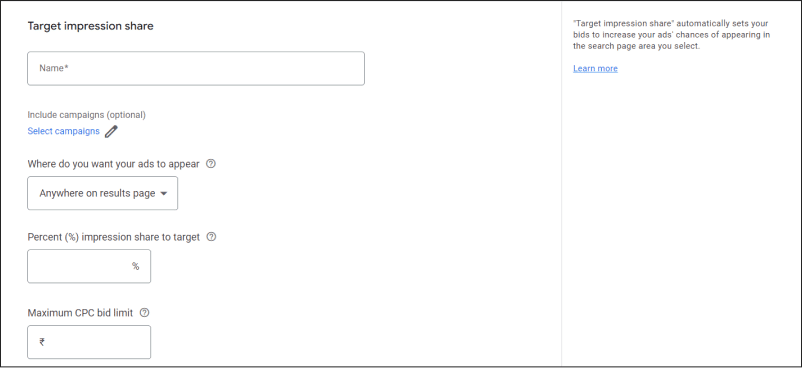
Pros:
- Increased Visibility: Target Impression Share bidding helps advertisers increase their ad visibility by optimizing bids to achieve the desired impression share in search results.
- Competitive Advantage: By maintaining a high impression share, advertisers can outbid competitors. This can help them secure prominent ad placements, enhancing their competitive advantage.
- Automated Optimization: The bidding algorithm automatically adjusts bids to help achieve the target impression share. This helps advertisers save their time and effort in bid management.
Cons:
- Cost Considerations: Increasing impression share may result in higher ad spend, especially in competitive auctions where bids are inflated.
- Limited Conversion Focus: Target Impression Share bidding prioritizes ad visibility over conversions. This may not be suitable for advertisers with specific conversion goals.
- Ad Rank Impact: While targeting a high impression share can improve ad visibility, it may not necessarily improve ad relevance or quality. This in turn potentially impacts ad rank and overall campaign performance.
Hybrid Bidding
While automated bidding strategies offer powerful tools, some advertisers crave more control. Hybrid bidding strategies bridge the gap. They allow you to leverage the power of automated bidding algorithms while maintaining some manual control over bids.
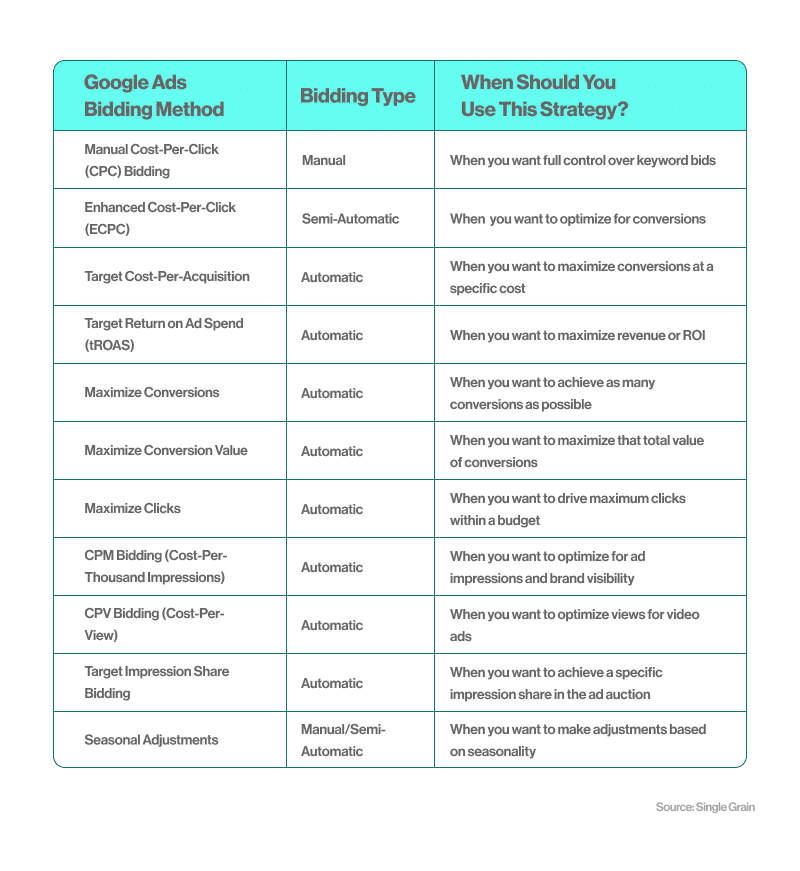
This can be particularly useful for specific campaigns or keywords where you have valuable insights or want to prioritize certain placements. One example of a hybrid strategy is Enhanced CPC (ECPC). Let’s check it out.
7. Enhanced CPC (eCPC)
Enhanced CPC (eCPC) bidding is a hybrid bidding strategy in which advertisers manually set their bids for clicks. The bidding algorithm adjusts those bids in real-time based on historical data and conversion likelihood.
If the algorithm predicts that a click is more likely to result in a conversion, it may increase the bid for that click, and vice versa. This strategy aims to maximize conversions while maintaining control over bidding decisions.
When to Use It:
- Mixed Performance: Enhanced CPC bidding is suitable for campaigns with mixed performance, where some keywords or ad placements perform well while others struggle to convert.
- Limited Conversion Data: When advertisers have limited conversion data available, eCPC bidding can help optimize bids based on available performance metrics and historical data.
- Manual Control: Advertisers who prefer manual bidding but want to leverage automated bid adjustments based on conversion likelihood can benefit from eCPC bidding.
Pros:
- Automated Optimization: Enhanced CPC bidding leverages machine learning to adjust bids based on conversion likelihood. This helps advertisers maximize conversions while maintaining manual control over bidding decisions.
- Improved Performance: By adjusting bids in real-time based on conversion probability, eCPC bidding can improve overall campaign performance and efficiency.
- Flexible Control: Advertisers have the flexibility to set manual bids while benefiting from automated bid adjustments. This allows for a balance between control and optimization.
Cons:
- The cons of the learning period and limited control are the same as mentioned above.
- Risk of Inefficiency: Without careful monitoring, there is a risk that automated bid adjustments may lead to inefficiencies or increased costs if not aligned with campaign goals or performance targets.
Conclusion
Choosing and testing SEM bidding strategies can feel overwhelming at first. There’s no one-size-fits-all solution. The best approach depends on your campaign goals, budget, and target audience.
By learning about different bidding options and using A/B testing and data analysis, you can make smart decisions to maximize your bid returns.
Remember, successful bidding is an ongoing process of experimentation and refinement.
As you gather data and gain insights into user behavior, you can continuously optimize your bids to maximize ROI and achieve your desired campaign outcomes. So, take control, experiment strategically, and watch your SEM campaigns flourish.
Also read: 17 Effective Tips to Improve Your Google Ads Click Through Rate


I’ve been visiting this site for years, and it never fails to impress me with its fresh perspectives and wealth of knowledge. The attention to detail and commitment to quality is evident. This is a true asset for anyone seeking to learn and grow.
I don’t usually read blog entries, but this one forced me to take a closer look. Your writing style has truly struck me as impressive. I appreciate your wonderful essay.
Your blog is a breath of fresh air in the often stagnant world of online content. Your thoughtful analysis and insightful commentary never fail to leave a lasting impression. Thank you for sharing your wisdom with us.
I have read some excellent stuff here Definitely value bookmarking for revisiting I wonder how much effort you put to make the sort of excellent informative website